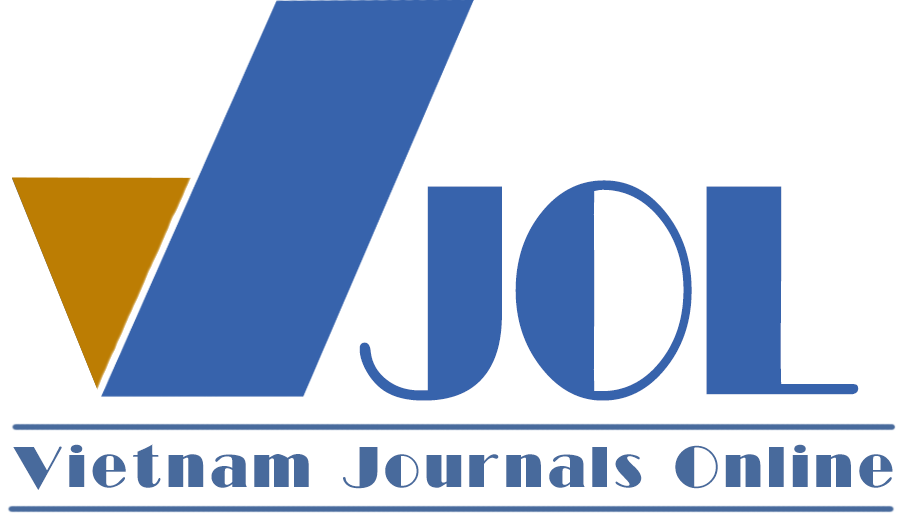Expanding the model of planned consumer behavior to explain tourists’ intention to Nha Trang to use green packaging products
Authors
DOI: https://doi.org/10.57110/jebvn.v3i1.166Keywords:
Intention, attitude, green packaging, touristsReferences
Andereck, K. L., Valentine, K. M., Knopf, R. C., & Vogt, C. A. (2005). Residents' perceptions of community tourism impacts. Annals of Tourism Research, 32(4), 1056–1076. https://doi.org/10.1016/j.annals.2005.03.001
Ritter, Á. M., Alves, R. R., & Silva, M. P. (2015). Motivations for promoting the consumption of green products in an emerging country: Exploring attitudes of Brazilian consumers. Journal of Cleaner Production, 106(1), 507–520. https://doi.org/10.1016/j.jclepro.2014.11.066
Zhang, G., & Zhao, Z. (2012). Green packaging management of logistics enterprises. Physics Procedia, 24(Part B), 900–905. https://doi.org/10.1016/j.phpro.2012.02.135
Wong, C. W. Y., Boon-itt, S., & Wong, C. Y. (2012). Green operations and the moderating role of environmental management capability of suppliers on manufacturing firm performance. International Journal of Production Economics, 140(1), 283–294. https://doi.org/10.1016/j.ijpe.2011.08.031
Ajzen, I. (1991). The theory of planned behavior. Organizational Behavior and Human Decision Processes, 50(2), 179–211. https://doi.org/10.1016/0749-5978(91)90020-T
Ajzen, I. (2002). Perceived behavioral control, self-efficacy, locus of control, and the theory of planned behavior. Journal of Applied Social Psychology, 32(4), 665–683.
Han, H., & Kim, Y. (2010). An investigation of green hotel customers’ decision formation: Developing an extended model of the theory of planned behavior. International Journal of Hospitality Management, 29(4), 659–668. https://doi.org/10.1016/j.ijhm.2010.01.001
Lee, J. S., Hsu, L. T., Han, H., & Kim, Y. (2010). Understanding how consumers view green hotels: How a hotel’s green image can influence behavioural intentions. Journal of Sustainable Tourism, 18(7), 901–914. https://doi.org/10.1080/09669581003777747
Cong, L. C., & Dam, D. X. (2017). Factors affecting the behavioral intention to use green tourism: A case study with international tourists to Nha Trang Beach City. Journal of Economics and Development, 241, 96–204.
Chan, R. Y. K. (2001). Determinants of Chinese consumers’ green purchase behavior. Psychology & Marketing, 18(4), 389–413. http://doi.org/10.1002/mar.1013
Han, H., Hsu, L.-T. J., Lee, J.-S., & Sheu, C. (2011). Are lodging customers ready to go green? An examination of attitudes, demographics, and eco-friendly intentions. International Journal of Hospitality Management, 29(4), 701–710. https://doi.org/10.1016/j.ijhm.2010.07.008
Han, H., Hsu, L. T., & Lee, J.-S. (2009). Empirical investigation of the roles of attitudes toward green behaviors, overall image, gender, and age in hotel customers’ eco-friendly decision-making process. International Journal of Hospitality Management, 28(4), 519–528. https://doi.org/10.1016/j.ijhm.2009.02.004
Stolz, J., Schlegelmilch, B. B., & Wurth, R. (2013). Consumers’ perception of the environmental performance in retail stores: An analysis of the German and the Spanish consumer. International Journal of Consumer Studies, 37(4), 394–399. https://doi.org/10.1111/ijcs.12028
Elliott, R. (2013). The taste for green: The possibilities and dynamics of status differentiation through green consumption. Poetics, 41(3), 294–322. https://doi.org/10.1016/j.poetic.2013.03.003
Peattie, K. (2010). Green consumption: Behavior and norms. Annual Review of Environment and Resources, 35(1), 195–228. https://doi.org/10.1146/annurev-environ-032609-094328
Paul, J., Modi, A., & Patel, J. (2016). Predicting green product consumption using theory of planned behavior and reasoned action. Journal of Retailing and Consumer Services, 29, 123–134. https://doi.org/10.1016/j.jretconser.2015.11.006
Yadav, R., & Pathak, G. S. (2016). Young consumers’ intention towards buying green products in a developing nation: Extending the theory of planned behavior. Journal of Cleaner Production, 135(1), 732–739. https://doi.org/10.1016/j.jclepro.2016.06.120
Bamberg, S., Ajzen, I., & Schmidt, P. (2003). Choice of travel mode in the theory of planned behavior: The roles of past behavior, habit, and reasoned action. Basic and Applied Social Psychology, 25(3), 175–187. https://doi.org/10.1207/S15324834BASP2503_01
Han, H., & Yoon, H. J. (2015). Hotel customers’ environmentally responsible behavioral intention: Impact of key constructs on decision in a green consumerism. International Journal of Hospitality Management, 45, 22–33. https://doi.org/10.1016/j.ijhm.2014.11.004
Birgelen, M. V., Semeijn, J., & Keicher, M. (2009). Packaging and pro-environmental consumption behaviour: Investigating purchase and disposal decisions for beverages. Environment and Behavior, 41(1), 125–146. https://doi.org/10.1177/0013916507311140
Cheah, I., & Phau, I. (2011). Attitudes towards environmentally friendly products: The influence of ecoliteracy, interpersonal influence, and value orientation. Marketing Intelligence & Planning, 29(5), 452–472. https://doi.org/10.1108/02634501111153674
Tsen, C. H., Lee, Y. H., & Lee, J. Y. (2006). Going green: A study of consumers’ willingness to pay for green products in Kota Kinabalu. International Journal of Business and Society, 7(2), 40–54.
Park, H. S. (2000). Relationships among attitudes and subjective norms: Testing the theory of reasoned action across cultures. Communication Studies, 51(2), 162–175. https://doi.org/10.1080/10510970009388516
Wang, Y., Li, X., & Zhang, Q. (2023). Understanding the purchase intention towards remanufactured products in closed-loop supply chains: An empirical study in China. International Journal of Physical Distribution & Logistics Management, 43(10), 866–888. https://doi.org/10.1108/IJPDLM-01-2013-0011
Maichum, K., Parichatnon, S., & Preechakaraj, N. (2016). Application of the extended theory of planned behavior model to investigate purchase intention of green products among Thai consumers. Sustainability, 8(10), 1077. https://doi.org/10.3390/su8101077
Moser, A. K. (2015). Thinking green, buying green? Drivers of pro-environmental purchasing behavior. Journal of Consumer Marketing, 32(3), 167–175. https://doi.org/10.1108/JCM-10-2014-1179
Prakash, G., & Pathak, P. (2017). Intention to buy eco-friendly packaged products among young consumers of India: A study on developing nation. Journal of Cleaner Production, 141, 385–393. https://doi.org/10.1016/j.jclepro.2016.09.116
Martinho, G., Silva, L. S., & Lopes, M. (2015). Factors affecting consumers’ choices concerning sustainable packaging during product purchase and recycling. Resources, Conservation and Recycling, 103, 58–68. https://doi.org/10.1016/j.resconrec.2015.07.012
Karbala, A., & Wandebori, H. (2012). Analyzing the factors that affect consumer’s purchase intention in Toimoi store, Indonesia. In Proceedings of the 2nd International Conference on Business, Economics, Management and Behavioral Sciences (pp. 13–14).
Munnukka, J. (2008). Customers’ purchase intentions as a reflection of price perception. Journal of Product & Brand Management, 17(3), 188–196. https://doi.org/10.1108/10610420810875106
Sønderskov, K. M., & Daugbjerg, C. (2011). The state and consumer confidence in eco-labeling: Organic labeling in Denmark, Sweden, the United Kingdom, and the United States. Agriculture and Human Values, 28(4), 507–517. https://doi.org/10.1007/s10460-010-9295-5
Agarwal, V., & Ganesh, L. (2016). Effectiveness and perception of 4P’s on green products in FMCG. International Journal of Multidisciplinary Research and Development, 3(4), 311–315. https://www.allsubjectjournal.com/assets/archives/2016/vol3issue4/3-4-95-262.pdf
Royne, M. B., D'Ambrosio, L. A., & Pashupati, R. (2011). The public health implications of consumers’ environmental concern and their willingness to pay for an eco-friendly product. Journal of Consumer Affairs, 45(2), 329–343. http://doi.org/10.1111/j.1745-6606.2011.01205.x
Thøgersen, J. (2000). Psychological determinants of paying attention to eco-labels in purchase decisions: Model development and multinational validation. Journal of Consumer Policy, 23(3), 285–313. https://doi.org/10.1023/A:1007122319675
Davis, N. W., & Duncan, M. C. (2016). Sport knowledge is power: Reinforcing masculine privilege through fantasy sport league participation. Journal of Sport and Social Issues, 30(3), 244–264. http://doi.org/10.1177/0193723506290324
Fabrigar, L. R., MacDonald, T. K., & Wegener, D. T. (2006). Understanding knowledge effects on attitude-behavior consistency: The role of relevance, complexity, and amount of knowledge. Journal of Personality and Social Psychology, 90(4), 556–577. https://doi.org/10.1037/0022-3514.90.4.556
Downloads
Additional Files
Published
Abstract View
PDF Downloaded
How to Cite
Issue
Section
License
Copyright (c) 2023 Lê Chí Công

This work is licensed under a Creative Commons Attribution-NonCommercial 4.0 International License.
by VNU Journal of Economics and Business






